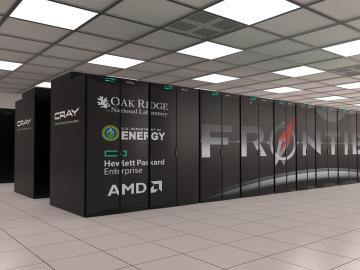
Filter News
Area of Research
- Biology and Environment (60)
- Biology and Soft Matter (1)
- Clean Energy (43)
- Computer Science (1)
- Electricity and Smart Grid (1)
- Fuel Cycle Science and Technology (1)
- Fusion and Fission (20)
- Fusion Energy (3)
- Isotopes (10)
- Materials (38)
- Materials for Computing (2)
- National Security (34)
- Neutron Science (19)
- Nuclear Science and Technology (1)
- Supercomputing (65)
News Type
News Topics
- 3-D Printing/Advanced Manufacturing (8)
- Artificial Intelligence (18)
- Big Data (10)
- Bioenergy (22)
- Biology (32)
- Biomedical (6)
- Biotechnology (3)
- Buildings (10)
- Chemical Sciences (14)
- Clean Water (7)
- Climate Change (38)
- Composites (3)
- Computer Science (20)
- Coronavirus (4)
- Critical Materials (1)
- Cybersecurity (9)
- Decarbonization (31)
- Emergency (1)
- Energy Storage (9)
- Environment (53)
- Exascale Computing (14)
- Fossil Energy (2)
- Frontier (17)
- Fusion (11)
- Grid (12)
- High-Performance Computing (25)
- Hydropower (5)
- Isotopes (8)
- ITER (1)
- Machine Learning (14)
- Materials (29)
- Materials Science (11)
- Mathematics (2)
- Mercury (2)
- Microelectronics (2)
- Microscopy (10)
- Nanotechnology (7)
- National Security (22)
- Net Zero (5)
- Neutron Science (22)
- Nuclear Energy (17)
- Partnerships (7)
- Physics (12)
- Polymers (3)
- Quantum Computing (11)
- Quantum Science (6)
- Renewable Energy (1)
- Security (3)
- Simulation (22)
- Software (1)
- Space Exploration (4)
- Summit (11)
- Sustainable Energy (22)
- Transportation (7)
Media Contacts

Unequal access to modern infrastructure is a feature of growing cities, according to a study published this week in the Proceedings of the National Academy of Sciences

ORNL scientists had a problem mapping the genomes of bacteria to better understand the origins of their physical traits and improve their function for bioenergy production.

David McCollum is using his interdisciplinary expertise, international networks and boundless enthusiasm to lead Oak Ridge National Laboratory’s contributions to the Net Zero World initiative.

ORNL, which is managed by UT-Battelle, LLC, is pleased to announce the award of four basic ordering agreements to local small businesses valued at up to $100 million.

The rapid pace of global climate change has added urgency to developing technologies that reduce the carbon footprint of transportation technologies, especially in sectors that are difficult to electrify.

Computational users at the Oak Ridge Leadership Computing Facility, or OLCF, are running scientific codes on Frontier’s architecture in the form of a powerful test system at the OLCF called Crusher.

The Center for Bioenergy Innovation at ORNL offers a unique opportunity for early career scientists to conduct groundbreaking research while learning what it takes to manage a large collaborative science center.

A study by researchers at the ORNL takes a fresh look at what could become the first step toward a new generation of solar batteries.

Bryan Piatkowski, a Liane Russell Distinguished Fellow in the Biosciences Division at ORNL, is exploring the genetic pathways for traits such as stress tolerance in several plant species important for carbon sequestration

A team of researchers working within the Center for Bioenergy Innovation at ORNL has discovered a pathway to encourage a type of lignin formation in plants that could make the processing of crops grown for products such as sustainable jet fuels easier and less costly.


